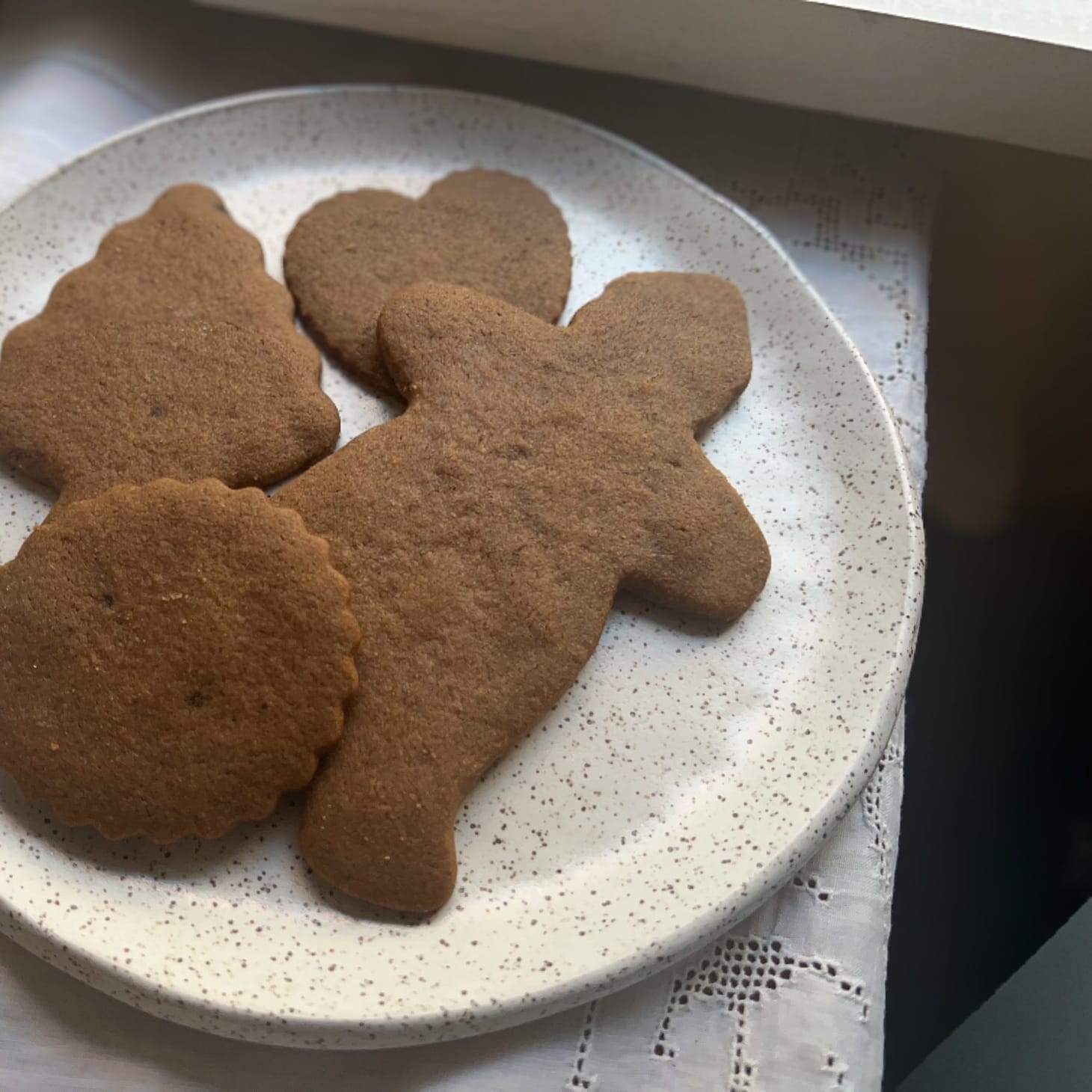Gingerbread Cookies
Better photos & more details coming soon!

Table of Contents

Gingerbread Cookies

Gingerbread Cookies656KB ∙ PDF fileDownloadDownload
Makes about forty 2-inch cookies
- Muscovado sugar (or better yet, if you can find it, Belgian Candi sugar) gives these cookies the appropriate caramelized sugar flavor. It should have a wet, soft texture and fine crystals.
- The rolled dough can be wrapped in plastic wrap and refrigerated for up to 5 days or frozen for up to one month. Thaw the dough overnight in the fridge if frozen.
- The dough scraps can be combined, rerolled, and chilled before cutting and baking. You can also bake the scraps as-is to keep yourself from eating all the "good" ones.
- For a pourable icing, whisk in milk or water a teaspoon at a time until the desired consistency is reached.
COOKIES
350g (2 ½ cups) all-purpose flour
1 tablespoon (8g) cinnamon
1 tablespoon (5g) ground dried ginger
1/2 teaspoon (1.3g) ground cardamom
1/2 teaspoon (1.4g) ground cloves
¾ teaspoon fine sea salt
¼ teaspoon baking powder
¼ teaspoon baking soda
200g (1 cup packed) muscovado sugar (or dark brown sugar if unavailable)
227g (16 tablespoons/2 sticks) unsalted butter, cut into 1/2-inch pieces and softened slightly
50g (1 large) egg
1 teaspoon vanilla extract
ICING
305g (2 ⅔ cups) confectioners' sugar
66g (2 large) egg whites
½ teaspoon vanilla extract
⅛ teaspoon fine sea salt
COOKIES: Whisk the flour, spices, salt, baking powder, and baking soda together in a small bowl. Set aside.
Place the butter and sugar in the bowl of a stand mixer fitted with a paddle, and beat on medium speed until light and fluffy, about 1 minute, scraping down the sides of the bowl as needed. Add the egg and vanilla extract and mix on medium-low until incorporated, about 30 seconds. Add the flour mixture and beat on medium-low speed until a uniform dough forms, about 30 seconds, scraping down the sides of the bowl as needed.
Transfer the dough to the counter and knead gently by hand until smooth, about 10 seconds. Divide the dough in half. Place 1 piece of dough in the center of a large sheet of parchment paper and press into a 7 by 9-inch oval. Place a second large sheet of parchment over the dough and—using a smearing or pushing motion with the pin—roll the dough into a 10 by 14-inch oval of even thickness. Transfer the dough with parchment to a rimmed baking sheet. Repeat pressing and rolling with the second piece of dough, then stack it on top of the first piece. Refrigerate until the dough is firm, at least 1 ½ hours (or freeze for 30 minutes).
Adjust an oven rack to the lower-middle position and heat the oven to 300˚F (150˚C). Working with 1 piece of rolled dough, gently peel off the top layer of parchment. Replace the parchment, loosely covering the dough. (Loosening the parchment makes cutting and removing the cookies way easier.) Invert the packet, gently peel off the top sheet of parchment, then use it to line a (preferably) rimless cookie sheet. Using a cookie cutter, cut the dough into shapes. Transfer the shapes to the prepared cookie sheet, spacing them at least ½ inch apart.
Bake until the cookies are lightly and evenly browned around their edges and browned on the underside1, 14 to 17 minutes, rotating the sheet halfway through baking. Let the cookies cool on the sheet for 5 minutes. Using a wide metal spatula, transfer cookies to wire rack and let cool completely. Repeat cutting and baking with the remaining sheet of dough.
ICING: Using a stand mixer fitted with the whisk attachment, whip the sugar, egg whites, vanilla, and salt on medium-low speed until combined, about 1 minute. Increase speed to medium-high and whip until glossy, soft peaks form, 3 to 4 minutes, scraping down the sides of the bowl as needed.
One problem with brown or otherwise dark-colored cookies is making sure they are fully baked without overbaking them. My solution is to carefully lift one up with an offset spatula and peek at the underside; if it is evenly browned, it’s a pretty good indicator. ↩
wordloaf Newsletter
Join the newsletter to receive the latest updates in your inbox.




